Abstract
Today, one of the serious problems of society is the problem of road accidents. Despite the introduction of modern safety standards both in the road construction industry and in engineering solutions in the automotive industry, the number of accidents on the roads is still quite high. The solutions we offer are aimed at teaching safe driving techniques from the initial level of training - through classes in preschool educational organizations, continuing with general educational school organizations and ending with secondary specialized and higher educational institutions. Classes are offered to be held both together with general physical training classes, and separately, in the form of circles and sections at educational organizations of both general and additional education. The general concept of the device of cars, the basics of traffic rules, the physical fundamentals of driving and movement of vehicles, taught from an early age, will contribute to an increase in driving culture and an overall reduction in road accidents. Additionally, an in-depth study of the device of a car and driving skills is possible, with the aim of further participation in professional competitions in motor sports.
Keywords: Children education, driving, improving traffic safety, car, sports
Introduction
A car is an irreplaceable thing in everyday life. A large number of people strive to acquire a vehicle, regardless of its type. Cars, motorcycles, mopeds, even bicycles make life much easier for a person: it becomes easier and faster to get from one point to another, there is a new opportunity to transport things, people with disabilities get access to faster and more convenient movement.
Not all people have the driving skill that comes with experience. After short driving lessons lasting one month, the driver finds himself on the road practically on his own. He acquires experience and skills alone, assimilating both right and wrong. But after how much time will a person be ready for emergency situations on the roads? A month of study, of which most of it is theory, does not provide self-confidence and certain skills. As a result, road traffic accidents (RTA) can occur.
A lot of people do not want to learn how to drive a vehicle, but rather get a driver's license by answering simple questions on an exam ticket. Such people may not be dangerous for other road users, they can safely move in the village and beyond, but it is they who will suffer from an uncontrolled car, which was introduced into such a state by a driver who neglects the rules of the road. In these accidents, a negative outcome could have been avoided, but driving schools do not teach techniques that help in emergency situations. These techniques can be learned as a result of practice, but most of the drivers do not have time to do it (Panov et al., 2016).
Problem Statement
According to the latest data, “14,302 people died in Russia in 2018” in road accidents (Mortality statistics, 2021). The number of deaths in road accidents is decreasing due to a decrease in alcohol consumption, tougher penalties for traffic violations, the emergence of video recorders, and an improvement in the quality of the vehicle fleet. However, according to the report of the World Health Organization (Global status report on road safety, 2018), the death rate on the roads in our country, compared to China, the USA and Europe, remains high. This is due to the fact that in many regions of Russia the medical ambulance service is poorly developed, and settlements located at a distance of 100 kilometers from each other can be served by only one paramedic; often on federal highways, cellular communication does not work well and, accordingly, there is no opportunity to call for medical assistance. Ineffective organization of work to provide medical care to victims of road accidents is one of the main reasons for their high mortality (Kuzmin, 2011).
Global deaths from road traffic crashes (RTAs) continue to rise, with 1.35 million deaths per year, and are the leading cause of death for children and young people aged 5-29. According to statistics from the World Health Organization, “every 24 seconds, one person dies in the world as a result of road traffic accidents” (Death on the roads, 2021). Child road traffic injuries are an integral part of the overall problem of road traffic injuries and road safety. The death of children for society and the state is not only human, but also politically significant, since it affects the infant mortality rate as a whole, which reflects the level of development and well-being of the country (Keshishyan, 2009). One of the priority directions of the state demographic policy of Russia is the creation of conditions for reducing the scale of child and adolescent injuries and deaths in road accidents, the realization of children's rights to safety in all areas of their lives (Ovcharenko et al., 2015).
As the report of the World Health Organization (Global status report on road safety, 2018) shows, high death rates from road accidents are observed in poor countries. Experts point out that this is due to underdeveloped infrastructure, bad roads and poor quality medical care, which is provided to people affected by road accidents. At the same time, in the list of countries with the highest fatality rates on the roads, one cannot find economically developed countries, which, obviously, provide appropriate conditions for car traffic and pay maximum attention to road safety. The most common causes of road accidents are indiscipline of drivers and pedestrians, driving under the influence of alcohol or drugs, insufficient qualification of drivers, gross violation of traffic rules, poor road conditions, unsatisfactory condition of streets and roads, technically faulty vehicle, and more (Martynyuk, 2016).
Table 1 provides information on accidents on the roads of the Russian Federation in March 2016 including indicated the total number of cases of injury and death of the participants in the incident. Table 2 provides information on accidents on the roads of the Russian Federation for February 2021. Despite the significant dynamics of reducing the number of accidents, their total number still remains very impressive.
Research Questions
Many people enter the roadway believing that they have a great store of knowledge gained as a result of training in educational organizations that train vehicle drivers. The average course, which is chosen by most people enrolled in the program for obtaining a driver's license to drive a car, consists of 1.5 months of training, of which 56 hours is practice. It is not difficult to calculate that if you practice for 3 hours a day, then the total amount of time allotted for driving instruction will be 19 days (56 ÷ 3 = 18.6), while 26 days will be allotted for theoretical training. The study of theory in online mode in groups is gaining popularity, as a result of which the student can turn off the camera, sound and not devote proper time to learning.
As a result, at the end of training in educational organizations that train drivers of vehicles, a person who could half-listen to the theory course and 19 incomplete days undergoing training in driving training gets behind the wheel and independently goes on the road. It will not be easy for such a driver to safely move on busy roads: he may not make a certain manoeuvre to prevent an accident, it will be difficult without practice to perform manoeuvres and actions in a modern dense traffic flow. As a result, the occurrence of road accidents is likely.
Purpose of the Study
In the context of driving training, the only way out of the situation is to gain experience as a result of practice. In order not to endanger yourself and other members of the road traffic, it is necessary to practice driving in a place where there are no strangers and cars. Driving training is possible from an early age. We conducted a survey for children from 3 to 18 years old and for their parents, as a result of which it was found out that most of the children in the future plan to travel by car, the second most popular transport is a bicycle. (Figure 1). Also, as a result of the test, it was revealed that 53.5% of children (Figure 2) and 71.3% of adults (Figure 3) of people believe that the training course in a driving school is not enough to move without accidents in a metropolis and beyond, and 65.9% of children believe that road accidents occur due to the driver's carelessness (Figure 4). The test involved 129 people, the result is shown in Figure 4.
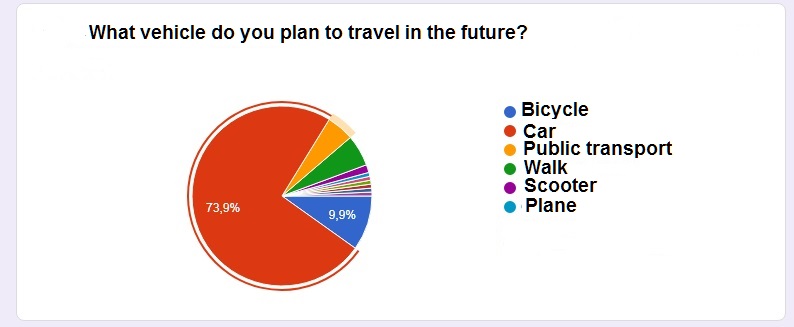
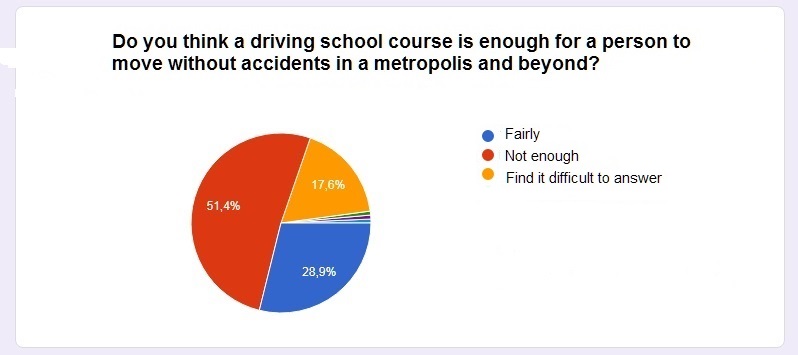
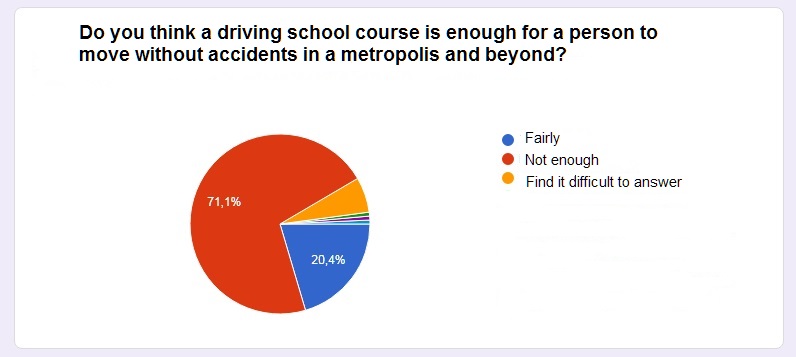
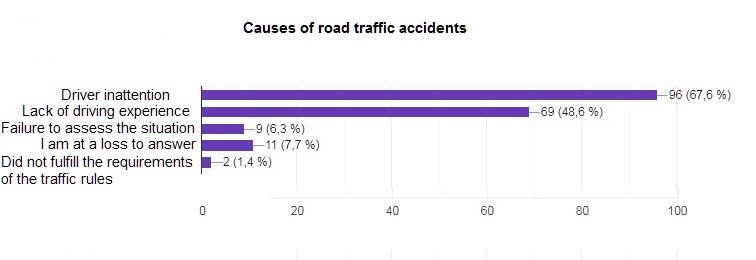
Research Methods
To solve the above problems, it is proposed to conduct driving lessons for children of different age groups.
Younger age group: 3-7 years old. Preschoolers
Practical part: classes are held in the courtyard of the kindergarten / specially equipped area / specially designated room on bicycles and pedal cars (Figure 5) during the educational process in the kindergarten. Possibly in any weather. A simple figure of limiting plastic cones is assembled on the site, the child's goal is to drive past the cones without hitting the latter. Classes are held in a playful way: they decorate the cones as people or animals, make clothes for them, a legend is invented, from which it follows that the cones are people / animals, etc. that go from work / from the forest / etc., the driver is a car that drove onto the road and must carefully drive along it, without touching a person / animal, etc.
Theoretical part: children are explained the basic driving regulations (DR) for a pedestrian (which light to move to, where to cross the road, how to behave in emergency situations on the road as a pedestrian).
The aim of the lesson: to understand driving a vehicle (V), comprehend the risk of road accidents, study the main traffic rules for pedestrians.
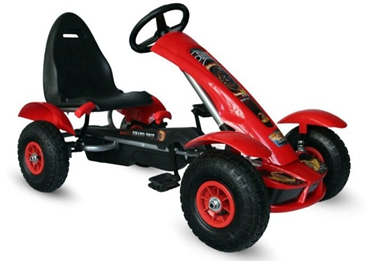
Children of 7-10 years old. Primary school students
Practical part: classes are held in the courtyard of an educational institution / gym / specially equipped area / specially designated room in cars such as “Kart” (Figure 6) after the school learning process. Fencing cones and tires are placed in the form of figures for automobile all-around. The child's goal is to drive a figure of cones and tires without hitting them. Additional mini-competitions are arranged.
Theoretical part: children are explained some traffic rules for vehicles, shown road signs. Tests are made in a playful way.
The aim of the lesson: to learn how to drive a car like “Kart”, to understand the tactics of movement, to study some traffic rules for cars.

Teenagers:10-18 years old. High school and senior high school students
Practical part: classes are held in the courtyard of an educational institution / gym / specially equipped area / specially designated room on modern passenger cars of category B. Training to get under way with a manual transmission, training to enter a turn at different speeds, training in parking and emergency actions situations on the roads. Cones and tires are placed in the form of figures for automobile all-around (Figure 7). The goal of a teenager is to pass a figure of cones and tires without hitting them. Theoretical part: a teenager learns various driving tactics, imagining himself in the place of a car, studies traffic rules, takes an exam on traffic rules in an online program. The aim of the lesson: to learn how to drive a car with a manual transmission, which has the ability to move on public roads. Acquire the necessary skills for various situations on the road, learn, remember all traffic rules and possible situations on the roads. Be able to apply knowledge about various situations on the roads and exits from them without hesitation.
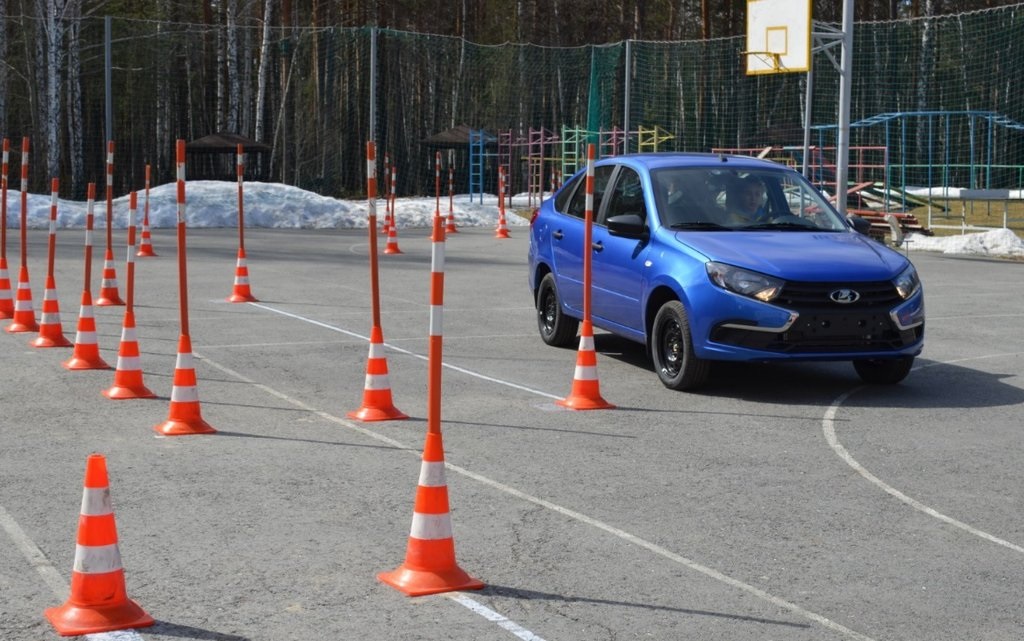
Findings
As a result of the monitoring and survey among persons over 18 years of age who have a driver's license and regularly drive vehicles, it was found that the number of road accidents involving pupils of sports sections and clubs involved in automobile or motorcycle sports in childhood and adolescence, is no more than 10% of the total number of all respondents (100 people). Thus, when learning to drive vehicles from an early age, it is possible to achieve a significant reduction in road traffic accidents. After obtaining a driver's license, persons who had additional driver training as a child will have great practical skills in preventing road accidents.
Conclusion
Traffic safety is a necessary thing that all people should be aware of. To avoid an accident, there should be people on the roads who are aware of the cost of their own and others' lives. These people must be literate in the field of traffic rules and situations that occur on the roads. Not everyone understands that this is very important. New laws, a large number of speed cameras, smart traffic lights, etc. prevent some dangerous situations on the road. But you need to look deeper, solve the problem in more effective ways.
It is in childhood that it is necessary to learn the basics of driving vehicles. In addition to gaining experience in driving vehicles, a child can engage in technical work - servicing and performing elementary repair work with vehicles, studying the physical foundations of movement and at the same time gaining practical knowledge in other general education subjects. If the child wants to further develop as a driver, you can move on to training in sections that cultivate motor sports as a way of leisure.
Children are plasticine in the hands of experienced adults. Children take death and harm to health hard. They believe in accidents; they believe that inexperienced or careless drivers are to blame. Children will not want to become those who harm themselves and others. Children always want to learn something new, so why not help them with this by offering not only something new, but really need something to do?
References
Death on the roads. (2021). Official website of the World Health Organization. https://extranet.who.int/roadsafety/death-on-the-roads/ (date of access: 02.03.21).
Global status report on road safety. (2018). Official website of the World Health Organization. https://apps.who.int/iris/bitstream/handle/10665/277370/WHO-NMH-NVI-18.20-eng.pdf?ua=1 (date of access: 02.03.21).
Keshishyan, R. A. (2009). Children's road traffic injuries (problems and solutions). VSP, 4. https://cyberleninka.ru/article/n/detskiy-dorozhno-transportnyy-travmatizm-problemy-i-puti-resheniya (date of access: 05/13/2021).
Kuzmin, A. G. (2011). Road traffic injuries as a national problem. Human Ecology, 3. https://cyberleninka.ru/article/n/dorozhno-transportnyy-travmatizm-kak-natsionalnaya-problema (date of access: 05/13/2021).
Martynyuk, S. N. (2016). Problems of classification and analysis of road traffic accidents. Society: Politics, Economics, Law, 3. https://cyberleninka.ru/article/n/problemy-klassifikatsii-i-analiza-dorozhno-transportnyh-proisshestviy (date of access: 05/13/2021).
Mortality statistics. (2021). Official website of the Federal State Statistics Service. Retrieved from: https://rosinfostat.ru/smertnost/ (date of access: 03/02/21).
Ovcharenko, M. S., Ovcharenko, A. A., & Kol’tsov, A. S. (2015). Analysis and forecast of road traffic accidents involving children in the Russian Federation. Izvestia SPbGAU, 39. https://cyberleninka.ru/article/n/analiz-i-prognoz-dorozhno-transportnyh-proisshestviy-s-uchastiem-detey-v-rf (date of access: 05/13/2021).
Panov, N. N., Tsygankov, E. S., Zudin, V. N., Britvina, V. N., & Konyukhov, V. G. (2016). Comparative analysis of road accidents in three countries: Germany, USA and Russia. Extreme human activity, 2, 19-24.
Copyright information

This work is licensed under a Creative Commons Attribution-NonCommercial-NoDerivatives 4.0 International License.
About this article
Publication Date
25 September 2021
Article Doi
eBook ISBN
978-1-80296-115-7
Publisher
European Publisher
Volume
116
Print ISBN (optional)
-
Edition Number
1st Edition
Pages
1-2895
Subjects
Economics, social trends, sustainability, modern society, behavioural sciences, education
Cite this article as:
Bakhteev, O., Kolganov, V., Apryshkin, D., & Bakhteeva, V. (2021). Improving Road Safety Through Motor Sports In Educational Institutions. In I. V. Kovalev, A. A. Voroshilova, & A. S. Budagov (Eds.), Economic and Social Trends for Sustainability of Modern Society (ICEST-II 2021), vol 116. European Proceedings of Social and Behavioural Sciences (pp. 2357-2364). European Publisher. https://doi.org/10.15405/epsbs.2021.09.02.263

